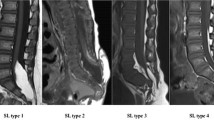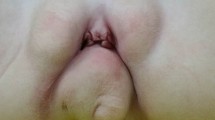Abstract
Purpose
Urethral duplication (UD) is a rare malformation, which can be associated with other anomalies, like anorectal malformations (ARM). ARM has been described with occult spinal dysraphism (OSD). No ARM-UD-OSD combination has been reported.
Aim
To share our experience and to discuss the management of ARM-UD-OSD association.
Methods
We retrospectively reviewed records of five boys with UD. Four of these had ARM-UD-OSD association. ARM was the first diagnosis in all; OSD and UD was detected during screening for associated malformation.
Results
All patients underwent ARM correction, 3 after colostomy. All reached fecal continence, 3 are performing bowel management. Three patients underwent UD surgical correction. Because of symptoms’ worsening, 2 children had detethering surgery. At a mean follow-up of 9.5 years, all patients have normal renal function, 3 are on clean intermittent catheterization (CIC) for neurogenic bladder (1 has a cystostomy, another one an appendicostomy).
Conclusions
UD and OSD should be considered in patients with ARM. Children with these conditions associated must be centralized in a third-level Center and management carefully planned; in particular, urethral reconstruction should be weighed, considering CIC could be required. Suspicion of neurogenic bladder must be present in OSD patient.



Similar content being viewed by others
References
Salle JL, Sibai H, Rosenstein D, Brzezinski AE, Corcos J (2000) Urethral duplication in the male: review of 16 cases. J Urol 163(6):1936–1940
Onofre LS, Gomes AL, Leão JQ, Leão FG, Cruz TM, Carnevale J (2013) Urethral duplication—A wide spectrum of anomalies. J Pediatr Urol. 9(6):1064–71. https://doi.org/10.1016/j.jpurol.2013.03.006
Das S, Brosman SA (1977) Duplication of the male urethra. J Urol 117(4):452–454. https://doi.org/10.1016/s0022-5347(17)58496-7
Ortolano V, Nasrallah PF (1986) Urethral duplication. J Urol 136(4):909–912. https://doi.org/10.1016/s0022-5347(17)45125-1
Effmann EL, Lebowitz RL, Colodny AH (1976) Duplication of the urethra. Radiology 119(1):179–185. https://doi.org/10.1148/119.1.179
Guglielmetti LC, Delcont M, Walker J, Wilcox D, Vuille-Dit-Bille RN (2020) Urethral duplication-Epidemiology, diagnosis, and treatment in a case series of 19 patients. J Pediatr Urol 16(3):385.e1-385.e9. https://doi.org/10.1016/j.jpurol.2020.02.010
Caione P, Angotti R, Molinaro F, Pellegrino C, Scuglia M, Gerocarni Nappo S, Messina M (2020) Urethral duplication in male epispadias: a very uncommon association. Minerva Urol Nefrol 72(2):229–235. https://doi.org/10.23736/S0393-2249.19.03271-5
Singal AK, Bhatnagar V, Agarwala S, Mitra DK (2006) Urethral duplication in association with anorectal malformation. Eur J Pediatr Surg 16(3):214–216. https://doi.org/10.1055/s-2006-924204
Nerli RB, Ghagane SC, Dixit NS, Hiremath MB (2018) Urethral duplication in a child with VATER association. Urol Case Rep 23:29–31. https://doi.org/10.1016/j.eucr.2018.11.018
Kang SK, Kim J, Lee YS, Han SW, Kim S (2020) Urethral duplication in male children: a study of 12 cases. J Pediatr Surg 55(10):2216–2220. https://doi.org/10.1016/j.jpedsurg.2019.12.012
Haleblian G, Kraklau D, Wilcox D, Duffy P, Ransley P, Mushtaq I (2006) Y-type urethral duplication in the male. BJU Int 97(3):597–602. https://doi.org/10.1111/j.1464-410X.2006.06025.x
Totonelli G, Messina R, Morini F, Mosiello G, Palma P, Scuglia M, Iacobelli BD, Bagolan P (2017) Embryological and clinical implications of the association between anorectal malformations and spinal dysraphisms. Pediatr Surg Int 33(8):843–847. https://doi.org/10.1007/s00383-017-4104-5
Van den Hondel D, Sloots C, de Jong TH, Lequin M, Wijnen R (2016) Screening and treatment of tethered spinal cord in anorectal malformation patients. Eur J Pediatr Surg 26(1):22–28. https://doi.org/10.1055/s-0035-1563673
Freitas Filho LG, Martins CS, Carnevale J, Kanasiro F, Budib LJ (2018) Spinal lipoma associated with urethral duplication. Urol Case Rep 19:11–12. https://doi.org/10.1016/j.eucr.2018.04.002
Mosiello G, Capitanucci ML, Gatti C, Adorisio O, Lucchetti MC, Silveri M, Schingo PS, De Gennaro M (2003) How to investigate neurovesical dysfunction in children with anorectal malformations. J Urol 170(4 Pt 2):1610–1613. https://doi.org/10.1097/01.ju.0000083883.16836.91
Kearns JT, Esposito D, Dooley B, Frim D, Gundeti MS (2013) Urodynamic studies in spinal cord tethering. Childs Nerv Syst 29(9):1589–1600. https://doi.org/10.1007/s00381-013-2136-2
Park K (2020) Urological evaluation of tethered cord syndrome. J Korean Neurosurg Soc 63(3):358–365. https://doi.org/10.3340/jkns.2020.0072
Stein R, Bogaert G, Dogan HS et al (2020) EAU/ESPU guidelines on the management of neurogenic bladder in children and adolescent part I diagnostics and conservative treatment. Neurourol Urodyn 39:45–57. https://doi.org/10.1002/nau.24211
Pascali MP, Mosiello G, Marciano A, Capitanucci ML, Zaccara AM, De Gennaro M (2011) A simplified technique for botulinum toxin injections in children with neurogenic bladder. J Urol 185(6 Suppl):2558–2562. https://doi.org/10.1016/j.juro.2011.01.037
Stein R, Bogaert G, Dogan HS et al (2020) EAU/ESPU guidelines on the management of neurogenic bladder in children and adolescent part II operative management. Neurourol Urodyn 39:498–506. https://doi.org/10.1002/nau.24248
Mosiello G, Lopes Mendes AL, Capitanucci ML, Zaccara AM, De Gennaro M (2017) Button cystostomy: is it really a safe and effective therapeutic option in pediatric patients with neurogenic bladder? Urology 101:73–79. https://doi.org/10.1016/j.urology.2016.09.025
Bradshaw CJ, Gray R, Downer A, Hitchcock R (2014) Button vesicostomy: 13 years of experience. J Pediatr Urol 10(1):80–87. https://doi.org/10.1016/j.jpurol.2013.06.008
Woodhouse CR, Williams DI (1979) Duplications of the lower urinary tract in children. Br J Urol 51(6):481–487. https://doi.org/10.1111/j.1464-410x.1979.tb03583.x
Golonka NR, Haga LJ, Keating RP, Eichelberger MR, Gilbert JC, Hartman GE et al (2002) Routine MRI evaluation of low imperforate anus reveals unexpected high incidence of tethered spinal cord. J Pediatr Surg 37(7):966–9. https://doi.org/10.1053/jpsu.2002.33817
Ailawadhi P, Kale SS, Agrawal D, Mahapatra AK, Kumar R (2012) Primary tethered cord syndrome–clinical and urological manifestations, diagnosis and management: a prospective study. Pediatr Neurosurg 48(4):210–215. https://doi.org/10.1159/000345829
Teo AT, Gan BK, Tung JS, Low Y, Seow WT (2012) Low-lying spinal cord and tethered cord syndrome in children with anorectal malformations. Singapore Med J 53(9):570–576
Tuuha SE, Aziz D, Drake J, Wales P, Kim PC (2004) Is surgery necessary for asymptomatic tethered cord in anorectal malformation patients? J Pediatr Surg 39(5):773–777. https://doi.org/10.1016/j.jpedsurg.2004.01.023
Suppiej A, Dal Zotto L, Cappellari A, Traverso A, Castagnetti M, Drigo P, Midrio P (2009) Tethered cord in patients with anorectal malformation: preliminary results. Pediatr Surg Int 25(10):851–855. https://doi.org/10.1007/s00383-009-2435-6
Capitanucci ML, Iacobelli BD, Silveri M, Mosiello G, De Gennaro M (1996) Long-term urological follow-up of occult spinal dysraphism in children. Eur J Pediatr Surg 6(suppl 1):25–26. https://doi.org/10.1055/s-2008-1071033
Inoue M, Uchida K, Otake K, Nagano Y, Shimura T, Hashimoto K et al (2017) Long-term functional outcome after untethering surgery for a tethered spinal cord in patients with anorectal malformations. Pediatr Surg Int 33(9):995–999. https://doi.org/10.1007/s00383-017-4127-y
Morimoto K, Takemoto O, Wakayama A (2003) Tethered cord associated with anorectal malformation. Pediatr Neurosurg 38(2):79–82. https://doi.org/10.1159/000068048
Podesta ML, Medel R, Castera R, Ruarte AC (1998) Urethral duplication in children: surgical treatment and results. J Urol 160(5):1830–1833. https://doi.org/10.1016/s0022-5347(01)62427-3
Fernbach SK (1991) Urethral abnormalities in male neonates with VATER association. AJR Am J Roentgenol 156(1):137–140. https://doi.org/10.2214/ajr.156.1.1898547
Lima M, Destro F, Di Salvo N, Gargano T, Ruggeri G (2017) Fate of males with urethral “Y-duplication”: 40-year long follow-up in 8 patients. J Pediatr Surg 52(8):1335–1339. https://doi.org/10.1016/j.jpedsurg.2016.11.034
Lorenz C, Zahn K, Schäfer FM, Möller K, Stehr M, Stein R (2021) Congenital Y-urethra—A diagnostic and therapeutic challenge. J Pediatr Urol 17(1):30–38. https://doi.org/10.1016/j.jpurol.2020.11.032
Stamates MM, Frim DM, Yang CW, Katzman GL, Ali S (2018) Magnetic resonance imaging in the prone position and the diagnosis of tethered spinal cord. J Neurosurg Pediatr 21(1):4–10. https://doi.org/10.3171/2017.3.PEDS16596
Funding
The authors did not receive support from any organization for the submitted work.
Author information
Authors and Affiliations
Contributions
Study conception and design: GM, CP, FL Data acquisition: FS, FB, FL, CP Analysis and data interpretation: AMZ, MLC, GE, DL, DB Drafting of the manuscript: BDI, TC, GL Critical revision: GM, PB, CEM, EC
Corresponding author
Ethics declarations
Conflict of interest
The authors have no relevant financial or non-financial interests to disclose.
Additional information
Publisher's Note
Springer Nature remains neutral with regard to jurisdictional claims in published maps and institutional affiliations.
Rights and permissions
About this article
Cite this article
Lena, F., Pellegrino, C., Zaccara, A.M. et al. Anorectal malformation, urethral duplication, occult spinal dysraphism (ARM-UD-OSD): a challenging uncommon association. Pediatr Surg Int 38, 1487–1494 (2022). https://doi.org/10.1007/s00383-022-05186-z
Accepted:
Published:
Issue Date:
DOI: https://doi.org/10.1007/s00383-022-05186-z




